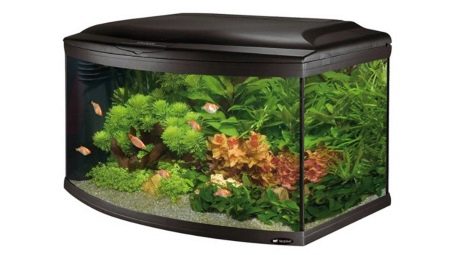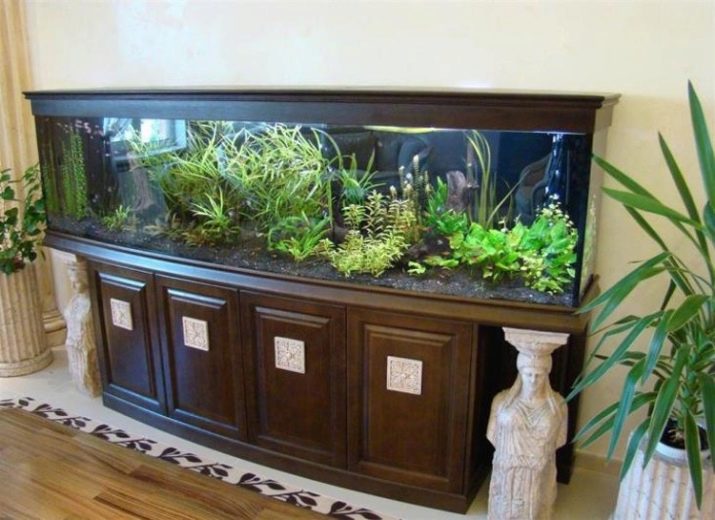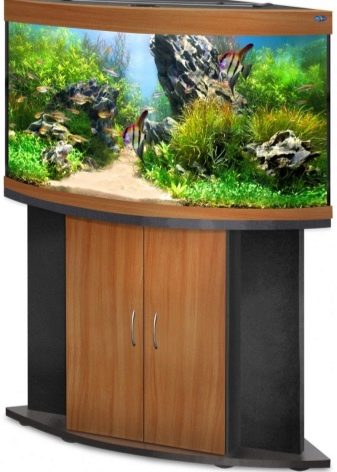Panoramic aquariums: features, varieties, selection and maintenance

The aquarium is a stylish addition to an interior with any design, a panorama of marine life right at your home. However, when buying, it is important to take care not only of the visual component, but also of your pets in order to choose the house that suits them.

Constructions
Domestic fish tanks are varied. By design, they are divided into decorative and auxiliary. Auxiliary (or special) aquariums are most often rectangular and low, the water level in them reaches 30-40 centimeters. This volume will be quite enough for a school of fry or for two small individuals.
The choice of decorative models is wider: they are spherical, cylindrical, triangular, angular, hexagonal and others.


In the recent past, all fish tanks were kept only on a metal frame, and therefore were limited to a rectangular shape. Models without a frame came to replace the frame ones - a modern look of the aquarium. They are durable and can withstand high water pressure. True, the glass is easily scratched.
Here are just a few of the types of modern frameless aquariums.
- Standard... The simplest model, easy to clean and does not take up much space. The rectangular shape allows for a good view of its inhabitants. Lighting in such aquariums is mounted under glass.
- Angular. It is possible to make according to any parameters so that the aquarium fits perfectly into the corner of the room. An excellent style solution: visually, it stretches the space, creating the illusion of volume.
- Cylindrical. It is undesirable to place this multifaceted aquarium close to the wall. Due to the specific shape and refraction of the edges, fish in it can look unnaturally large.It should be positioned centrally so that visibility is available from all sides of the cylinder.
- Panoramic... One of the most popular today. The panoramic viewing glass increases the viewing angle - you can observe aquatic life from almost any corner of the room. We will pay attention to this model.


Glass or acrylic?
These two materials are equally commonly used in the construction of aquariums. Let's figure out how they differ, and what is better to choose.
Acrylic tanks are famous for:
- great variety;
- low cost;
- durability;
- ease.
The main disadvantage of such material is that acrylic glass scratches easily, so wipe it down very gently.
Too cheap acrylic can turn yellow over time. In addition, such an aquarium should not be cleaned with household chemicals - they impair the transparency of acrylic.
Glass as a material for an aquarium is very inferior to acrylic. Perhaps its only plus is that the most inexpensive glass tank looks more presentable than the cheapest acrylic one.
When choosing an aquarium, give preference to those made of acrylic... Their seams are strong and leak-proof, withstand the pressure of 200 liters of water.

Optimal volume
If you are a beginner, then, most likely, decide to opt for the smallest option: 30 or 60 liters. But this is fundamentally the wrong approach. The smaller the aquarium, the more difficult it is to debug the biological cleaning system in it. Do not purchase tanks less than 30 liters. If you received such an aquarium as a gift with a school of fish already inhabited, it is better to immediately move them to a larger house. To calculate the optimal volume, you need to determine how many fish will live in one vessel.
If you have more than three pairs of fish, it is advisable to place them in an aquarium of at least 150 liters.
If possible, take a 250 liter tank.
Buy filters, coolers and heaters additionally.

Panorama features and benefits
Panoramic aquariums look modern and unusual, resembling a flat TV screen. The "image" hardly stretches or deforms.
A trapezoidal or spherical panoramic aquarium is a win-win option that will perfectly complement both office and home interiors. You can put such a decor element both on a regular curbstone and on a chest of drawers with additional drawers. This solution will make the design much more functional and useful.
The panoramic corner view is perfect for a small room that doesn't have room for a bulky rectangular tank. Here again, the effect of stretching the space and imitation of its depth will play.
Why is a panoramic aquarium better than a rectangular one:
- panoramic has fewer problems with glass, it does not stretch due to its convex shape;
- such a model takes up much less space and will stylistically fit into any interior;
- a rectangular tank looks old-fashioned, angular and awkward, often causing inconvenience with sharp corners, and panoramic aquariums are much more viable in this regard.


There are different design options for panoramic models with a volume of 100, 120, 150 or 200 liters.
Usually, three separate species are distinguished from panoramic aquariums.
- Arch panoramic. The glass on this model is more curved thanks to the decorative panels on the sides and the convexity of the acrylic.
- Painting. Such a tank is hung or leans against the wall and, indeed, resembles a living picture. The classic version is a rectangular aquarium built into a deep niche. The glass is decorated with a frame.
- Table. Such forms are attached to the wall using brackets. This construction requires a very strong wall that can support the weight of a heavy vessel. It is located parallel to the floor and visually resembles a shelf or table.


Why does he need a cover:
- without it there will be no necessary lighting and temperature;
- it prevents debris and dust from entering the aquarium;
- water does not evaporate, which allows you to change it less often;
- ensures safety - no fish will jump out of the aquarium to the surface.
You can make the cover yourself, but first you need to calculate and measure the aquarium. Consider cleaning: depending on how you position the lid parts, it may be inconvenient to clean the tank later.
The cover material must be moisture resistant and not afraid of high temperatures. You can opt for foamed PVC - this is a proven solution.
The pros and cons of panoramic aquariums are listed in the following video.









Of course, the larger the volume of the aquarium, the easier it is to keep it clean, but again it depends on the type, number of fish and equipment. It is not necessary to start with a 300 liter aquarium, you can get by with a 20 liter one and plant shrimps and a flock of neons there. It will not be worse for anyone if you have good equipment, do tests and timely replacements with soil cleaning.